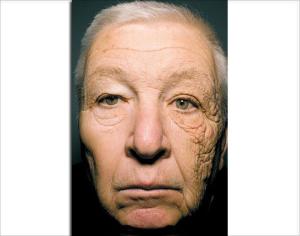Article Summary
- The four factors of aging skin
- The four ways to minimize the signs of aging
- The best active ingredients to add to an anti-aging skincare routine
Your skin’s structure
Before I get into it, let’s do a quick biology lesson. Your skin has three layers: the epidermis (the really thin, outermost layer); the dermis (a thicker layer below that); and the hypodermis (a fat-storing layer that links the skin to the tissues below). In terms of skincare and aging, we mostly care about the epidermis and dermis.
In the dermis, see that orange-tan stuff? That’s called the dermal extracellular matrix. It’s basically the scaffolding that holds the shape of your skin in place, and gives it its firmness and ability to bounce back. It’s a gel-like structure made of collagen, elastin, and glycosaminoglycans (like hyaluronic acid).
The biology of aging
Because of that matrix, your dermis is crucial in maintaining the plumpness and bounce of youthful skin. As it degrades over time, you start seeing the sagging, droopy skin associated with aging. The epidermis is also important in aging; it dries out over time, losing both lipid and water content, giving older skin that papery quality.
Scientists aren’t 100% sure what causes wrinkles, but it probably comes partly from a breakdown in the bond between the dermis and the epidermis. As they start to break away from each other, rifts form and become wrinkles.
Extrinsic vs. intrinsic aging
There are two types of factors at play with skin aging: extrinsic (external/environmental) and intrinsic (from within your body).
The number 1 extrinsic factor is sun exposure. UV radiation has a serious effect on the skin; beyond the risk of melanoma, UV radiation degrades your dermal collagen and prevents new collagen synthesis. Other extrinsic factors, like smoking and air pollution, have a similar effect. Extrinsic factors cause a lot of damage, but the good news is that we have a lot of control over them (wear sunscreen and don’t smoke, basically).
Intrinsic factors are a different story; these are just natural things that happen in our body as we get older. A lot of this is due to decreasing levels of sex hormones – for women, a lot of skin aging takes place after menopause – but also comes from general wear and tear of living and getting older.
Some of the ways skin changes naturally as you get older include:
- Skin gets thinner as cell turnover decreases – epidermis loses about 6.4% thickness every decade
- Skin gets drier – sebum production decreases by up to 60%, and water content decreases dramatically (partially due to less hyaluronic acid in the epidermis)
- Skin barrier integrity decreases, meaning it’s slower to repair itself
- Collagen and elastin levels in the dermis decrease
- Production of collagen and elastin slows
The aging caused by extrinsic factors actually looks different than intrinsic aging. Extrinsic factors like sun exposure lead to coarse wrinkles, sun spots, and thick, leathery-looking skin, while natural intrinsic factors cause fine wrinkles, increased laxity, and pale, delicate-looking skin.
How to prevent the signs of aging
You can only truly prevent those extrinsic factors. Always wear sunscreen! On average, UV damage is responsible for 80% of the signs of aging. If you want to see how dramatic it can be, here’s a photo of a man who drove a delivery truck for 28 years and so only had UV exposure through his driver’s side window:
Smoking causes similar damage – check out these side-by-sides of identical twins where only one twin smokes.
How to treat the signs of aging
You may not be able to prevent all signs of aging, but you can mitigate it quite a bit. The four main factors in the appearance of aging skin are:
- Less collagen
- Less elastin
- Drier skin
- Thinner skin
Good news: of those four, there’s only one we have zero control over. Scientists haven’t yet found a way to increase elastin production, so as that stuff starts to break down, it’s just gone. We can treat the other three, though!

Make more collagen
- Retinoids (these can also fade pigmentation spots, another sign of aging)
- Vitamin C
- Glycolic acid
Keep the collagen you have
- Vitamin C
- Vitamin E
- Niacinamide (it regulates cell metabolism and regeneration, and can also increase skin elasticity and fade pigmentation spots)
Keep your skin from thinning
- AHAs like glycolic acid
- Retinoids
- Niacinamide
Treat dry skin
- Hyaluronic acid
-
Ceramides and cholesterol
- Plant oils high in linoleic acid
When should I start this routine?
Honestly, you can start focusing on anti-aging whenever you want. So much of anti-aging is about preserving the skin you have that it’s pretty much always easier to start young. I started noticing my own fine lines when I was 25 or 26, so that might be a good age to start.
I want to end this post with an important message, though: there’s nothing bad about aging! Your skin naturally goes through a lot of changes throughout your life, and those wrinkles are a testament to your wisdom and experience. If you want bouncy, youthful skin, great! If you want to wear your wrinkles and spots as badges of a life well lived, awesome. Personally, I try to avoid the outside of my eyes during my anti-aging routine, because I really love my budding crows’ feet. They remind me how much I’ve laughed in my life. I hope they get enormous.


